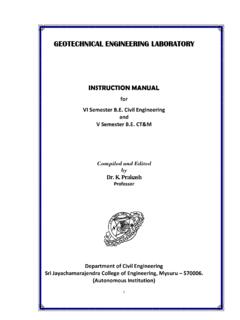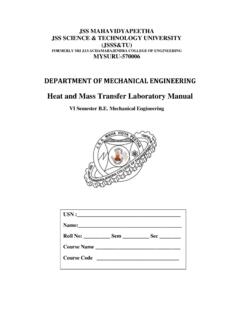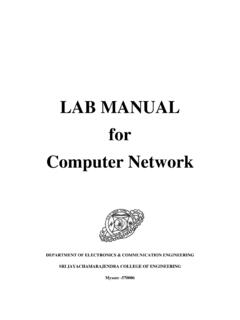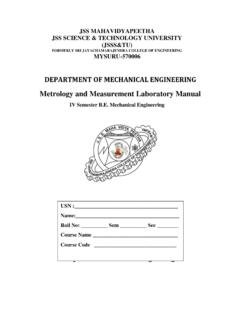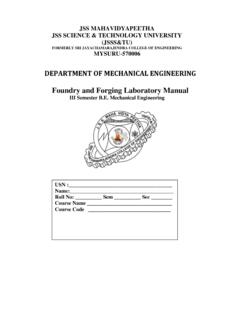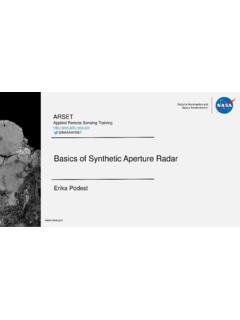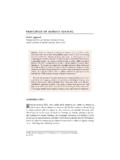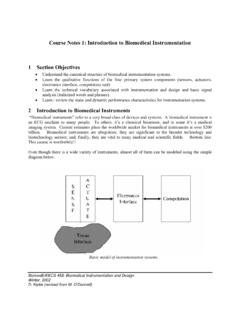Transcription of REMOTE SENSING AND GIS APPLICATIONS
1 REMOTE SENSING AND. GIS APPLICATIONS . V. Madhava Rao Associate Professor Department of Civil Engineering , Mysore-570 006. INDIA. Population Nearly 20% of world's population Area Nearly Adult literacy Less than 50%. 2060 billion population, 400 M tonne food requirement (181 M tonne availability). Per-capita forest wealth (lowest). Soil Erosion 10 tonne per hector DEMAND OF THE DAY. Monitoring and management of resources. Sustainable development. Disaster Mitigation HAZARDS. Natural Hazards Hazards Caused by Man NATURAL HAZARDS.
2 Heavy toll of life Property loss Homeless and destitute people DISASTER MANAGEMENT. Disaster Management Before the Event After the Event Prevention Preparedness Relief Rehabilitation Prevention DISASTER MITIGATION. Mitigation Reduce or lessen Hazard assessment Type, Frequency, Magnitude, Map of area likely to be affected. Vulnerability assessment Assessing degree of loss of population, buildings infrastructure, economic activities. Risk Assessment Quantifying numbers of lives likely to be lost, cost of damage to property Preparation of maps, indicating risk areas DISASTER MITIGATION.
3 Restrictive zoning Acquisitions of hazardous areas, removal of unsafe structures, insurance and real-estate information Protective engineering solutions Building codes Example: Earthquake resistance design code Public Information DISASTER MITIGATION. Disaster Preparedness Activities intended to be prepared, once a disaster event is going to happen Preparation of disaster plan Coordination of emergency services. Anticipating damage to critical facilities - Damage to main roads, hospitals etc. Damage inspection, repair and recovery procedures Availability of trained personnel DISASTER MITIGATION.
4 Communications and control center Disaster training exercises Rehearsal Prepare evacuation plans Informing / training population Forecast, warning, prediction of disaster DISASTER MITIGATION. Disaster relief Rapid damage assessment Implementation of disaster response plan Establish communication and infrastructure Search and rescue operation Speed of information Real time information . Arial photogrammetry Damage assessment Quantification of damage DISASTER MITIGATION. Requirement Large amount of data Real time data Tool to analyse and interpret data Solution REMOTE SENSING GIS.
5 REMOTE SENSING . Information Collection Interpretation No physical contact HISTORY OF REMOTE SENSING . The invention of photography in 1839 made REMOTE SENSING (eventually) possible. REMOTE SENSING began in the 1860s as balloonists took pictures of the Earth's surface. Pigeon fleets were another form of REMOTE SENSING in the early years. HISTORY OF REMOTE SENSING . HISTORY OF REMOTE SENSING . HISTORY OF REMOTE SENSING . HISTORY OF REMOTE SENSING . HISTORY OF REMOTE SENSING . ELECTRO MAGNETIC ENERGY. Energy that moves with the velocity of light (3 x 108 m/s).
6 Distance PLATFORMS. ELECTRO MAGNETIC SPECTRUM. uv B G R ELECTRO MAGNETIC SPECTRUM. m m visible range 1 m mm infrared 10 mm microwave 1 m and above radio wave 10-2 m ultra violet 10-4 m to 10-2 m X-ray Less than 10-4 m Gamma ray INTERACTION MECHANISM. Change in intensity Change in wave length Change in direction Change in Phase REMOTE SENSING SYSTEMS. Organic Eye In-organic Framing Cameras Vidicons Scanning Ideal Source Constant intensity for all wave lengths Ideal Sensor Different intensity for different wave length REMOTE SENSING SYSTEMS.
7 Ideal Medium Processor Storage User REMOTE SENSING SYSTEMS. Active Sensor Own source Passive Sensor Other source Example Camera without flash Camera with flash SATELLITE. An eye in the sky that does not tell lie TYPES OF SATELLITES. Geo-stationery Approximately 36000 km altitude Velocity 3075 m/s (Earth's speed in its axis). Orbital period 24 Hrs West to East APPLICATIONS Meteorological, Communication Example: INSAT. TYPES OF SATELLITES. Sun Synchronous Lower altitude 817 km High resolution Example IRS 1C.
8 IMPORTANT REMOTE SENSING SATELLITES. LANDSAT USA. 714 km 16 days 30 m resolution m to m coastal water mapping, soil / vegetation differentiation SPOT FRANCE. 813 km 10 m 26 Days Stereo IRS 1A. Operational REMOTE SENSING Weight 975 kg onboard 600 Watts power Communicat S-band, X-bandand VHF. ion (commanding only). Three axis body stabilized (zero momentum). Stabilization with4 Reactions Wheels, Magnetic torquers Monopropellan Htydrazine based with RCS sixteen 1 thrusters Three solid state Push Broom Cameras: LISS-1( resolution), Payload LISS-2A and LISS-2B ( resolution).
9 IRS 1A. Operational REMOTE SENSING Launch March 17,1988. date Launch site Baikanur Cosmodrome Launch Vostok vehicle Orbit 904 km PolarSun-synchronous Inclination deg Repetivity 22 days (307orbits). Local time (descending node). life Three years (nominal). Orbital life Long IRS 1B. Mission Operational REMOTE SENSING Weight 975kg onboard power 600 Watts Communication S-band,X-bandand VHF(commanding only). Stabilization Three axis body stabilized (zero momentum) with 4 Reactions Wheels, Magnetic torquers RCS Monopropellant Hydrazine based with sixteen 1 Newton thrusters Payload Three solid state Push Broom Cameras LlSS-1.
10 ( metre resolution), LlSS-2A and LlSS-2B ( metre resolution). Launch date August 29,1991. Launch site Baikanur Cosmodrome Kazakhstan IRS 1B. Launch vehicle Vostok Orbit 904km Polar Sun Synchronous Inclination deg Repetivity 22 days Local time (descending node). Mission life Three years (nominal). Orbital life Long IRS-1E. Mission Operational REMOTE SENSING Weight 846kg onboard power 415 Watts CommunicationS-band (TIC) & VHF. Stabilization Three axis body stabilized ( zero momentum) with 4 Reaction Wheels, Magnetic torquers RCS Monopropellant Hydrazine based RCS with 1 Newton thrusters ( 16 Nos.)

